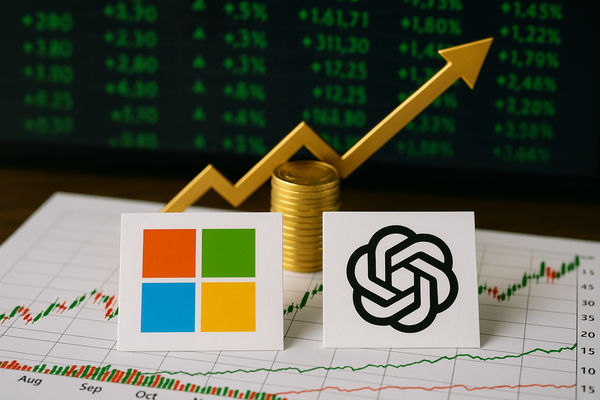
Apple hits $4 trillion on iPhone 17 momentum and market rally
Apple (NASDAQ:AAPL) surged back above a $4 trillion market cap after reports of brisk early iPhone 17 sales in the U.S. and China and a fresh market rally. The move matters now because Big Tech earnings and a looming Federal Reserve decision are concentrating flows into a handful of large-cap names. In the short term, iPhone cycles and earnings headlines are driving price action. Over the longer term, product roadmaps — foldables, OLED MacBooks, and M-series upgrades — set structural revenue paths. Globally, Asia and Europe matter for supply and demand; locally, U.S. funds are reallocating into tech leaders faster than during past iPhone cycles.
Market Pulse Check
Investors pushed major U.S. equity indices to new highs as attention swung to artificial intelligence partnerships and hardware cycles. Heavyweights drew most inflows while some suppliers traded on deal and earnings news. Two contrasting examples stood out:
- Microsoft (NASDAQ:MSFT) rallied after a restructured OpenAI deal was reported, drawing institutional buying into cloud and AI names.
- Corning (NYSE:GLW), a key Apple supplier, slipped after weaker-than-expected optical fiber sales and new tariffs in China hit revenue forecasts.
ETF and mutual fund flows favored large-cap tech exposure again, concentrating liquidity. That amplified swings: winners got larger; some smaller-cap suppliers saw fast reversals when guidance disappointed.
Analyst Convictions — upgrades, reiterations and price-target moves
Analysts were active this week. Wedbush reiterated an Outperform on Apple (NASDAQ:AAPL) with a $310 target ahead of earnings, highlighting iPhone momentum. Broker notes also lifted other Big Tech targets as AI themes surfaced.
- Skyworks (NASDAQ:SWKS) and Qorvo (NASDAQ:QRVO) merger chatter and a planned deal lifted both supplier stories; some brokers upgraded Skyworks on the consolidation play.
- Broadcom (NASDAQ:AVGO) appeared on buy lists as funds rebalanced into semiconductor infrastructure names that benefit from cloud and AI capex.
These convictions emphasize valuation gaps. In some cases, high analyst conviction sits beside cautious market pricing — a reminder that coverage and flows can diverge sharply over weeks.
Risk Events vs. Expansion — tariffs, supplier disappointments and product roadmaps
Risk events clustered around supplier execution and trade policy. Corning (NYSE:GLW) reported optical fiber weakness tied to slower network investment in China and a new anti-dumping tariff. That undercut some Apple supply-chain optimism in the short run.
Meanwhile, expansion stories persisted:
- Skyworks and Qorvo agreed to merge, creating a roughly $22 billion radio-frequency chip group. That consolidation aims to secure smartphone RF supply for Apple (NASDAQ:AAPL) and others.
- Apple’s product pipeline — reports of a 2027 iPad Pro with advanced cooling, OLED upgrades to MacBook Air and iPad lines, and speculation around a foldable iPhone — supports a multi-year hardware upgrade cycle.
So the market is weighing near-term policy and execution risks against medium-term product-driven revenue expansion for device and infrastructure suppliers.
Leadership and Fundamentals & Investor Sentiment
Leadership moves and fundamentals paint a mixed picture. On leadership, Microsoft (NASDAQ:MSFT) and Nvidia (NASDAQ:NVDA) grabbed headlines with big AI deals and infrastructure work, attracting institutional allocations. Apple (NASDAQ:AAPL), by contrast, combined product momentum with steady cash flow and buyback narratives.
On fundamentals, earnings previews matter. Several Big Tech reports this week — including Apple (NASDAQ:AAPL) and Amazon (NASDAQ:AMZN) — created headline volatility. Institutional traders reacted differently than retail: block trades and ETF rebalances showed institutions rotating into AI-tilted names, while retail flows favored product stories and momentum plays.
Valuation disconnects are visible. Some suppliers with solid revenue beats saw shares punished when guidance disappointed. Conversely, heavily covered AI infrastructure names sometimes rallied even with stretched multiples, driven by concentrated demand from active managers.
Investor Signals Ahead
These contrasting storylines suggest a few near-term investor signals. First, earnings reports and the Fed calendar remain the immediate catalysts that will reallocate flows across large caps and suppliers. Second, consolidation among component suppliers (Skyworks (NASDAQ:SWKS) + Qorvo (NASDAQ:QRVO)) will reshape who benefits from handset upcycles. Third, trade policy, especially China tariffs, is an active risk for optical and telecom suppliers like Corning (NYSE:GLW).
For market participants, the coming weeks may reinforce sector leadership among AI cloud names and stable hardware franchises, while testing whether supplier and trade risks can be priced in. Watch liquidity patterns: concentrated inflows can accelerate winners, while earnings surprises still trigger rapid re-rating across the ecosystem.
Note: article draws on recent company reports, market flow indicators and broker notes reported this week. This is informational, not investment advice.












